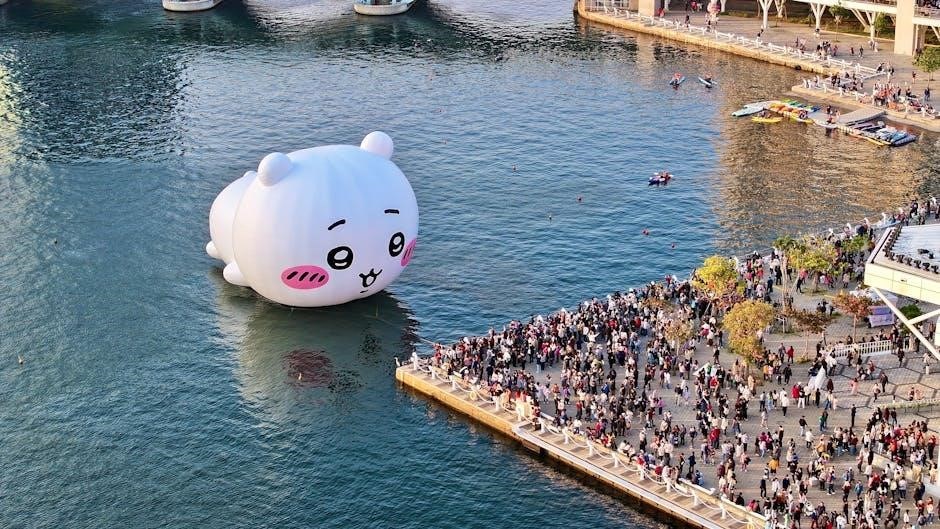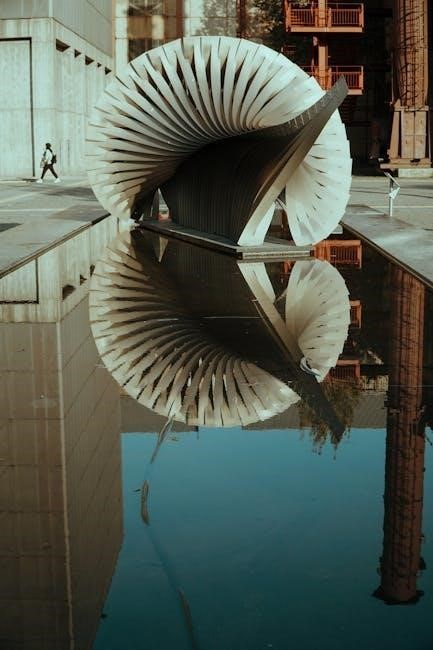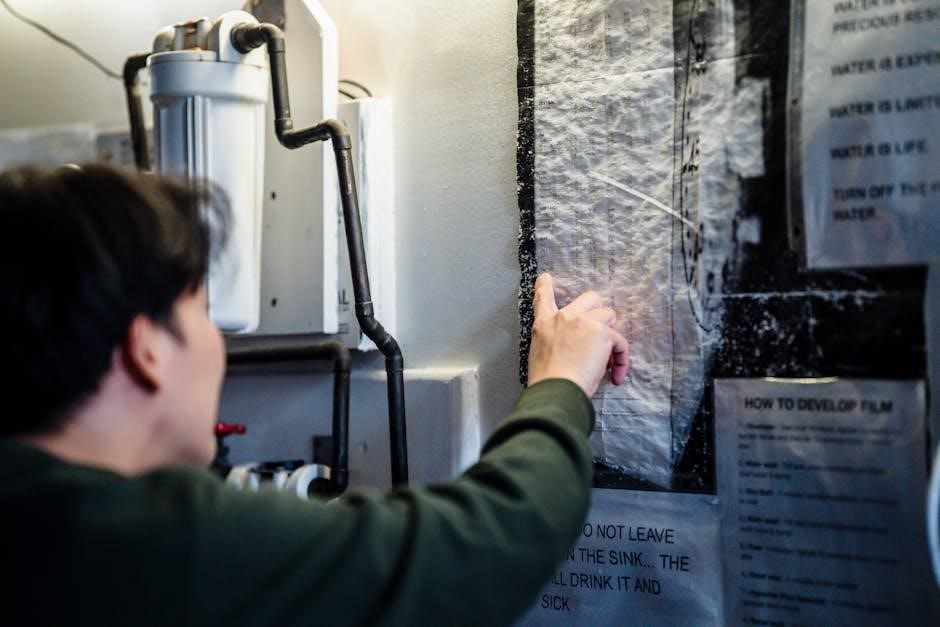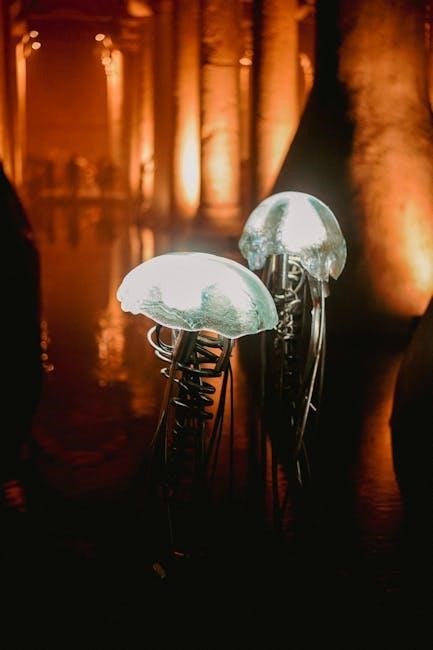Rheem tankless water heaters offer efficient, reliable, and continuous hot water solutions. This guide provides a comprehensive overview of installation processes, ensuring safety, compliance, and optimal performance.
1.1 Overview of Rheem Tankless Water Heaters
Rheem tankless water heaters are innovative, energy-efficient solutions designed to provide continuous hot water without the need for a storage tank. Available in electric, natural gas, and propane models, these units cater to various household needs. The RTEX-27, for instance, is a high-efficiency electric model featuring three heating chambers for consistent performance. Rheem also offers condensing tankless water heaters with BTU ratings up to 199,000, ensuring ample hot water supply. These units are compact, space-saving, and can be installed indoors or outdoors, depending on the model. With advanced temperature controls and eco-friendly designs, Rheem tankless water heaters are known for their reliability and durability, often backed by comprehensive warranties. Their energy efficiency and ability to save space make them a preferred choice for modern homes.
1.2 Importance of Proper Installation

Proper installation of a Rheem tankless water heater is critical for safety, efficiency, and compliance with local codes. Incorrect installation can lead to fire hazards, gas leaks, or reduced performance. Ensure all connections, including venting and electrical systems, are correctly configured to avoid risks. Following manufacturer instructions and local regulations ensures optimal function and prevents potential voiding of warranties. Improper venting can cause dangerous conditions, while incorrect electrical setups may result in malfunctions. Always use qualified professionals for installation to guarantee safety and efficiency. Proper installation also ensures energy efficiency, reducing operational costs and extending the unit’s lifespan. Compliance with safety standards is non-negotiable to protect both the system and the household. Remember, proper installation is the foundation for reliable and safe operation of your Rheem tankless water heater.
1.3 Safety Precautions and Warnings
When installing a Rheem tankless water heater, strict adherence to safety guidelines is essential to prevent hazards. Always follow the manufacturer’s instructions and local safety codes. Ensure proper ventilation to avoid carbon monoxide risks and maintain clearances from combustible materials. Electrical connections must be grounded correctly to prevent shocks or fires. Avoid installing the unit in areas prone to moisture, dust, or water splashing. Never attempt repairs or adjustments without disconnecting the power and gas supply. Improper installation can lead to fire, explosion, or personal injury. Use only approved materials and tools to ensure compatibility and safety. Failure to comply with safety precautions may void the warranty or result in dangerous conditions. Always prioritize caution and consider hiring a licensed professional for a safe and reliable installation.

Pre-Installation Preparation
Select a suitable location for installation, ensuring compliance with local codes and manufacturer guidelines. Gather all necessary tools and materials, and ensure proper ventilation and plumbing preparation.

2.1 Sizing and Selecting the Right Model
Choosing the right Rheem tankless water heater involves assessing your household’s hot water needs. Consider factors like water usage patterns, peak demand, and climate. Rheem offers various models, such as the RTEX-27, designed for high efficiency and performance; Ensure the unit’s GPM (gallons per minute) and temperature rise capabilities match your requirements. Proper sizing prevents undersupply or excessive energy use. Refer to Rheem’s sizing guides or consult a professional to select the optimal model for your home. Incorrect sizing can lead to poor performance or increased energy costs, making this step crucial for a successful installation.
2.2 Choosing the Installation Location
Selecting the right location for your Rheem tankless water heater is essential for optimal performance and safety. Ensure the area is well-ventilated, protected from freezing temperatures, and not prone to excessive moisture or humidity. Avoid installing near flammable materials or in confined spaces without proper ventilation. For outdoor installations, use appropriate weather-resistant models and follow Rheem’s guidelines to prevent damage from environmental factors. The unit should be securely mounted on a sturdy surface, such as a wall stud, using the provided bracket to ensure stability and safety. Always refer to the manufacturer’s instructions for specific location recommendations to guarantee compliance and efficiency.
2.3 Gathering Necessary Tools and Materials
Before starting the installation, ensure you have all the required tools and materials. Essential tools include a tubing cutter, adjustable wrench, pliers, screwdrivers, and a drill with bits. For materials, you’ll need appropriate gas and water lines, PEX tubing, fittings, and venting components as specified by Rheem. Additionally, gather a mounting bracket, screws, and any required adapters. Always refer to the manufacturer’s instructions for specific material recommendations. Safety gear like gloves and goggles is also crucial. Make sure to have a copy of the installation manual handy for reference. Proper preparation ensures a smooth and efficient installation process, avoiding delays and potential issues. Double-check local codes for any additional requirements before proceeding.

Installation Process
The installation involves securing the unit, connecting water and gas lines, and ensuring proper venting. Follow Rheem’s instructions for precise steps and safety compliance.
3;1 Mounting the Tankless Water Heater
Mounting the Rheem tankless water heater requires a sturdy surface, such as a wall stud or framing, using the provided bracket. Ensure it’s level and secure to prevent vibration or movement. The unit should be installed in an area with adequate ventilation, away from combustible materials. Follow Rheem’s installation manual for specific mounting instructions to ensure safety and efficiency. Proper mounting is crucial for the heater’s performance and longevity. Always refer to the manufacturer’s guidelines to avoid installation errors.
3.2 Plumbing Connections and Water Lines
Proper plumbing connections are essential for the efficient operation of a Rheem tankless water heater. Begin by ensuring the cold water supply line is connected to the inlet port, while the hot water line is connected to the outlet port. Use a minimum of ¾-inch piping to meet code requirements and prevent flow restrictions. PEX tubing is recommended for its flexibility and resistance to scaling. Install isolation valves on both the hot and cold lines to facilitate maintenance and servicing. Additionally, a backflow preventer may be required to ensure safe water flow direction. Always follow local plumbing codes and Rheem’s specific instructions for connections. Properly secure all fittings and test for leaks before finalizing the installation.
3.3 Electrical Connections and Wiring
Proper electrical connections are critical for the safe and efficient operation of a Rheem tankless water heater. Begin by ensuring the unit is connected to a dedicated 120VAC, 20-amp circuit, as specified in the installation manual. For outdoor installations, hardwiring is required, while indoor units can use a standard 3-prong grounded outlet. Do not connect the water heater to a GFCI or AFCI circuit, as this may cause operational issues. Ensure all wiring is properly sized and meets local electrical codes. Grounding the unit is essential for safety and performance. If the water heater requires higher power, such as 240V for certain models, consult a licensed electrician to ensure correct wiring. Always test the electrical connections before finalizing the installation to avoid potential hazards.
3.4 Venting Requirements and Installation
Proper venting is essential for the safe and efficient operation of a Rheem tankless water heater. Direct venting to the outdoors is required, as specified in the installation instructions. Use a venting kit approved by Rheem, ensuring compliance with local codes and regulations. The venting system must be installed with proper clearances from combustible materials to prevent fire hazards. For certain models, such as condensing units, specialized venting materials like Category III stainless steel may be required. Ensure the venting system is airtight and correctly sized for the unit to maintain optimal performance. Always follow the manufacturer’s guidelines for vent termination and clearance requirements. Improper venting can lead to safety risks, including carbon monoxide buildup, so careful installation is critical. Consult local authorities for specific venting regulations and ensure the system is inspected after installation.

Safety Guidelines and Regulations
Adhere to local codes, ensure proper ventilation, and maintain clearance from combustibles. Avoid installing in hazardous locations and comply with safety standards for optimal performance and risk reduction.
4.1 Compliance with Local Codes and Standards
Compliance with local codes and standards is essential for a safe and legal installation of your Rheem tankless water heater. Always verify regional building regulations and ensure your installation meets these requirements. This includes obtaining necessary permits and scheduling inspections. Proper venting, electrical connections, and plumbing must align with local safety standards to prevent hazards. Rheem provides detailed guidelines in their manuals, but local authorities may have additional stipulations. Failure to comply can result in legal issues or safety risks. Ensure all installations are performed by qualified professionals familiar with local codes. Adhering to these regulations guarantees optimal performance and longevity of your water heater while safeguarding your property and occupants. Always refer to Rheem’s installation manual and consult local authorities for specific requirements before proceeding.

4.2 Venting Safety and Clearances

Proper venting is critical for safe operation of your Rheem tankless water heater. Always follow the manufacturer’s venting instructions to prevent hazards like carbon monoxide buildup. Ensure venting materials meet local and national standards, using approved categories for gas venting. Maintain required clearances from combustible materials, typically 6-12 inches, depending on the vent type. The venting system must be airtight to prevent gas leaks and ensure proper exhaust flow. Regularly inspect vents for blockages or damage. For outdoor installations, ensure vents are protected from freezing temperatures and debris. Failure to adhere to venting safety guidelines can lead to fire hazards or system malfunction. Always comply with Rheem’s specifications and local safety standards to ensure a secure and efficient installation. Proper venting ensures optimal performance and protects your home and family from potential risks.
4.3 Electrical Safety and Grounding
Electrical safety is paramount when installing a Rheem tankless water heater. Ensure all wiring meets local electrical codes and the unit’s specifications. Use a dedicated 120VAC, 3-prong grounded circuit for indoor models, avoiding GCFI or AFCI circuits. For outdoor installations, hardwiring is required, and a suitable weatherproof outlet may be necessary. Proper grounding prevents electrical shocks and ensures safe operation. Connect the grounding wire securely to a compatible grounding system. Avoid using extension cords or overloaded circuits, as they can cause fire hazards or system failure. Regularly inspect electrical connections for wear or damage. Always follow Rheem’s installation instructions and consult a licensed electrician if unsure. Compliance with electrical safety standards ensures reliable performance and protects against potential risks. Proper grounding and wiring are essential for safe and efficient operation of your Rheem tankless water heater.

Post-Installation Steps
After installation, test the water heater, set the temperature, and perform final safety checks. Monitor performance and ensure all systems operate as intended for optimal efficiency.
5.1 Testing the Water Heater
After installation, turn on the water heater and check for leaks in all connections. Ensure the unit activates correctly and heats water consistently. Verify the temperature setting matches your preferences and monitor the system for proper flow rate. Test both hot and cold water supply lines to ensure they function independently without mixing. Check the remote control or digital interface for accurate temperature display and responsiveness. Verify that safety features, such as overheat protection, are functioning. Refer to the manufacturer’s instructions for specific testing procedures. Ensure all vents and exhaust systems are clear and operating as intended. If any issues arise, consult the troubleshooting guide or contact a certified technician. Proper testing ensures the system operates safely and efficiently, meeting your household needs.
5.2 Setting the Temperature and Controls
Once the water heater is installed and tested, set the desired temperature using the remote control or digital interface. The default temperature is typically around 120°F but can be adjusted to suit your needs. Use the control panel to increase or decrease the temperature in increments, ensuring it displays accurately. Most Rheem models allow temperature adjustments between 100°F and 140°F. For safety, avoid exceeding 140°F to prevent scalding. If your model has advanced features, you can program schedules or energy-saving modes. Refer to the user manual for specific instructions on locking controls or setting temperature limits. After adjusting, allow a few minutes for the system to stabilize and verify the temperature at a faucet to ensure accuracy. Proper temperature setting ensures optimal performance and energy efficiency while maintaining safety standards. Always follow the manufacturer’s guidelines for temperature adjustments.
5.3 Final Safety Checks and Inspections
After completing the installation, conduct a thorough safety inspection to ensure everything is functioning correctly and safely. Check all plumbing, electrical, and venting connections for leaks or damage. Verify that the temperature setting does not exceed safe limits (typically below 140°F) to prevent scalding. Ensure the unit is properly grounded and all safety features, such as child locks, are activated. Turn on the water heater and test it by running hot water through a faucet to confirm it operates smoothly. Refer to the user manual for specific safety checks tailored to your model. Finally, inspect the area around the unit to ensure it is clear of combustible materials and meets local code requirements. Always have a licensed professional perform the final inspection to guarantee compliance and safety.

Maintenance and Troubleshooting
Regular maintenance ensures optimal performance. Clean filters, check for leaks, and descale as needed. Refer to the user manual for troubleshooting common issues promptly.
6.1 Regular Maintenance Tips
Regular maintenance is crucial for optimal performance of your Rheem tankless water heater. Start by cleaning or replacing air and water filters every 6-12 months to ensure proper airflow and water quality. Check for any signs of leaks around connections and address them promptly. Descale the heater annually, especially in hard water areas, to prevent mineral buildup. Inspect the venting system for blockages or damage, ensuring it’s clear and functioning correctly. Refer to the user manual for specific guidance on maintenance procedures tailored to your model. Additionally, schedule annual professional inspections to identify and resolve potential issues before they escalate. By following these tips, you can extend the lifespan of your tankless water heater and maintain its efficiency and reliability.
6.2 Common Issues and Solutions
Common issues with Rheem tankless water heaters include error codes, inconsistent water temperature, and reduced water flow. Error codes can often be resolved by resetting the unit or checking for loose connections. Temperature fluctuations may require adjusting the temperature setting or ensuring proper water flow rates. Low water flow can be caused by scale buildup, which can be addressed through descaling. Ignition issues may indicate problems with the gas supply or venting, which should be inspected and corrected by a professional. Always refer to the user manual for specific troubleshooting guidance. If issues persist, contact a licensed technician to avoid further complications. Regular maintenance and prompt repairs can help prevent these issues and ensure long-term efficiency and reliability of your Rheem tankless water heater.
6.3 Warranty and Service Information
Rheem tankless water heaters are backed by comprehensive warranties, typically covering parts and labor for 5 to 10 years, depending on the model and installation. Proper registration of the product is essential to activate the warranty. Users should review the warranty terms to understand coverage limitations and exclusions. For service-related issues, Rheem provides customer support through their official website and helpline. Authorized service technicians are recommended for repairs to ensure compliance with warranty conditions. Regular maintenance, as outlined in the user manual, is often required to maintain warranty validity. If issues arise, contact Rheem’s customer service for assistance with troubleshooting or scheduling a certified technician. Always keep records of installation, maintenance, and repairs for warranty verification purposes.
Proper installation ensures efficiency, safety, and reliability. Follow Rheem’s guidelines for optimal performance and warranty compliance. Professional installation is recommended for long-term satisfaction and trouble-free operation.
7.1 Summary of Key Installation Steps
Installing a Rheem tankless water heater involves several critical steps to ensure safety and efficiency. First, size and select the appropriate model for your needs, then prepare the installation site. Mount the unit securely, ensuring proper ventilation and clearances. Connect water and gas lines according to manufacturer specifications, and install electrical connections safely. Venting must comply with local codes and Rheem’s guidelines to prevent hazards. After installation, test the system thoroughly, set the temperature, and perform final safety checks. Regular maintenance and adherence to warranty terms are essential for long-term performance. Always follow Rheem’s installation manual and local regulations to avoid potential risks and ensure optimal functionality.
7.2 Final Thoughts and Recommendations
Installing a Rheem tankless water heater requires careful planning and adherence to manufacturer guidelines. Key takeaways include proper sizing, safe venting, and electrical compliance. Always hire a licensed professional for complex tasks. Regular maintenance ensures longevity and efficiency. Follow local codes and Rheem’s instructions to avoid hazards. Consider eco-friendly models for energy savings. Proper temperature settings and clearances are crucial. Keep the unit away from moisture and dust. Refer to the manual for troubleshooting and warranty details. Rheem’s customer support is available for assistance. By following these steps, you’ll enjoy reliable, energy-efficient hot water for years. Remember, safety and compliance are paramount for optimal performance and longevity of your Rheem tankless water heater.



